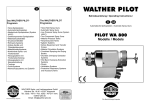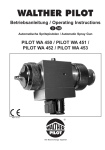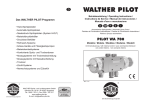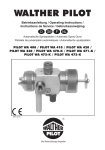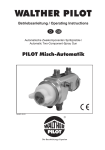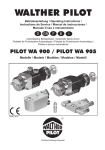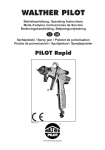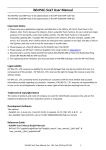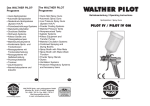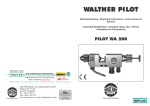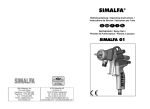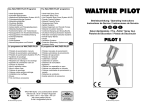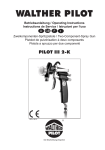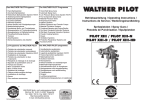Download WALTHER PILOT - WSB Finishing Equipment
Transcript
Das WALTHER PILOTProgramm The WALTHER PILOT Programme • Hand-Spritzpistolen • Automatik-Spritzpistolen • Niederdruck-Spritzpistolen (System HVLP) • Zweikomponenten-Spritzpistolen • Materialdruckbehälter • Drucklose Behälter • Rührwerk-Systeme • Airless-Geräte und Flüssigkeitspumpen • Materialumlaufsysteme • Kombinierte Spritz- und Trockenboxen • Absaugsysteme mit Trockenabscheidung • Absaugsysteme mit Naßabscheidung • Pulversprühstände • Trockner • Zuluft-Systeme • Atemschutzsysteme und Zubehör • Hand-Held Spray Guns • Automatic Spray Guns • Low Pressure Spray Guns (System HVLP) • Two-Component Spray Guns • Material Pressure Tanks • Nonpressurized Tanks • Agitator Systems • Airless Equipment and Transfer Pumps • Material Circulation Systems • Combined Spraying and Drying Booths • Dry Back Overspray Extraction Systems • Wet Back Overspray Extraction Systems • Powder Spray Stands • Dryers • Ventilation Systems • Protective Respiratory Systems and Accessory Items WALTHER Spritz- und Lackiersysteme GmbH Kärntner Str. 18-30 • 42327 Wuppertal Tel.: 0202 / 787-0 • Fax: 0202 / 787-217 www.walther-pilot.de Email: [email protected] WA LTH ER PI LOT Betriebsanleitung / Operating Instructions Automatische Spritzpistolen / Automatic Spray Guns PILOT WA 800 Modelle / Models PILOT WA 800-HD Mit Innensteuerung / with internal control Ohne Innensteuerung / without internal control PILOT WA 805-HD EG-Konformitätserklärung Declaration of CE-Conformity Wir, der Gerätehersteller, erklären in alleiniger Verantwortung, daß das Produkt in der untenstehenden Beschreibung den einschlägigen grundlegenden Sicherheits- und Gesundheitsanforderungen entspricht. Bei einer nicht mit uns abgestimmten Änderung an dem Gerät oder bei einer unsachgemäßen Verwendung verliert diese Erklärung ihre Gültigkeit. We, the manufacturers of the equipment, hereby declare under our sole responsibility that the product(s) described below conform to the essential safety requirements. This declaration will be rendered invalid if any changes are made to the equipment without prior consultation with us. Hersteller Manufacturer Typenbezeichnung Verwendungszweck WALTHER Spritz-und Lackiersysteme GmbH Kärntner Str. 18-30 D-42327 Wuppertal Tel.: 0202 / 787-0 Fax: 0202 / 787-217 www.walther-pilot.de • Email: [email protected] Automatische Spritzpistolen PILOT WA 800-Serie WA 800-HD (Hochdruck mit Innensteuerung) WA 805-HD (Hochdruck ohne Innensteuerung) WA 810-HD-U (Hochdruck-Umlauf mit Innensteuerung) WA 815-HD-U (Hochdruck-Umlauf ohne Innensteuerung) WA 820-ND (Niederdruck mit Innensteuerung) WA 825-ND (Niederdruck ohne Innensteuerung) WA 830-ND-U (Niederdruck-Umlauf mit Innensteuerung) WA 835-ND-U (Niederdruck-Umlauf ohne Innensteuerung) WA 840-MD (Mitteldruck mit Innensteuerung) WA 845-MD (Mitteldruck-ohne Innensteuerung) WA 850-MD-U (Mitteldruck-Umlauf mit Innensteuerung) WA 855-MD-U (Mitteldruck-Umlauf ohne Innensteuerung) WA 870-HD-K (Hochdruck-Kleberausführung ohne Innen.) WA 871-HD-K-U (Hochdruck-Kleberausführung-Umlauf o. Innen.) WA 872-ND-K (Niederdruck-Kleberausführung ohne Innen.) WA 873-ND-K-U (Niederdruck-Kleberausführung-Umlauf o. Innen.) Type Designation V V V V V V V V V V V V V V V V 20 20 20 20 20 20 20 20 20 20 20 20 20 20 20 20 800 805 810 815 820 825 830 835 840 845 850 855 870 871 872 873 Intended purpose Verarbeitung spritzbarer Materialien 20 20 20 20 20 20 20 20 20 20 20 20 20 20 20 20 800 805 810 815 820 825 830 835 840 845 850 855 870 871 872 873 Processing of sprayable media Specification according 94 / 9 / CE Spezifikation im Sinne der Richtlinie 94 / 9 / EG Gerätebezeichnung V V V V V V V V V V V V V V V V Applied Standards and Directives EU-Machinery Directive 98 / 37 CE 94 / 9 EC (ATEX Directives) DIN EN 292 Part 1 DIN EN 292 Part 2 DIN EN 1953 Angewandte Normen und Richtlinien EG-Maschinenrichtlinien 98 / 37 EG 94 / 9 EG (ATEX Richtlinien) DIN EN 292 Teil 1 DIN EN 292 Teil 2 DIN EN 1953 Kategorie 2 WALTHER Spritz-und Lackiersysteme GmbH Kärntner Str. 18-30 D-42327 Wuppertal Tel.: 0202 / 787-0 Fax: 0202 / 787-217 www.walther-pilot.de • Email: [email protected] Automatic Spray Gun PILOT WA 800-Models WA 800-HD (High pressure with internal control) WA 805-HD (High pressure without internal control) WA 810-HD-U (High pres.-circulation with internal control) WA 815-HD-U (High pres.-circulation without internal c.) WA 820-ND (Low pressure with internal control) WA 825-ND (Low pressure without internal control) WA 830-ND-U (Low pres.-circulation with internal control) WA 835-ND-U (Low pres.-circulation without internal c.) WA 840-MD (Mediem pressure with internal control) WA 845-MD (Medium pressure without internal control) WA 850-MD-U (Medium pres.-circulation with internal c.) WA 855-MD-U (Medium pres.-circulation without internal c.) WA 870-HD-K (High pressure-adhesive version) WA 871-HD-K-U (High pressure-adhesive version-circulation) WA 872-ND-K (Low pressure-adhesive version) WA 873-ND-K-U (Low pressure-adhesive version-circulation) II 2 G c T 5 Tech.File,Ref.: 2407 Category 2 Part marking II 2 G c T 5 Tech.File,Ref.: 2407 Besondere Hinweise : Das Produkt ist zum Einbau in ein anderes Gerät bestimmt. Die Inbetriebnahme ist so lange untersagt, bis die Konformität des Endproduktes mit der Richtlinie 98 / 37 / EG festgestellt ist. Special remarks : The named product is intended for installation in other equipment. Commissioning is prohibited until such time as the end product has been proved to conform to the provision of the Directives 98 / 37 / CE. Wuppertal,den 7. Juli 2003 Wuppertal, the 7th of July 2003 i.V. i.V. Name: Torsten Bröker Stellung im Betrieb: Leiter der Konstruktion und Entwicklung Name: Torsten Bröker Position: Manager, Design and Development Diese Erklärung ist keine Zusicherung von Eigenschaften im Sinne der Produkthaftung. Die Sicherheitshinweise der Produktdokumentation sind zu beachten. This Declaration does not give assurance of properties in the sense of product liability.The safety instructions provided in the product documentaion must be observed at all times. Ersatzteilliste: PILOT WA 800-HD (Hochdruck mit Innensteuerung) V 20 800 Abweichende Ersatzteile von Modell PILOT WA 800-HD Pos. Nr. 1 2 Pos. Nr. 14 27 30b-36 Ersatzteile: PILOT WA 805-HD (Hochdruck ohne Innensteuerung) 3 4 5 6 7 8 9 10 11 12 13 14 15 16 17 18 19 20 21 22 23 24 25 26 27 28 29 30a 30b 31 32 33 34 35 36 Artikelnummer Bezeichnung V 11 360 04 300 wahlweise: V 11 360 30 060* V 11 360 30 210* wahlweise: V 20 810 35 . . 3* V 11 700 09 200 V 20 810 14 003 V 20 810 10 003 V 20 810 14 203 V 09 102 33 009 V 09 002 53 000 V 20 810 42 103 V 09 103 64 009 V 22 650 43 100 V 09 220 30 000 V 20 810 40 000 V 20 810 20 100 V 09 103 65 000 V 20 810 10 510 V 20 810 10 520 V 20 606 11 000 V 20 810 33 000 wahlweise: V 20 810 30 . . 3* V 20 510 29 003 V 20 810 32 000 V 20 510 34 000 V 09 103 66 000 V 20 810 05 000 V 66 101 53 015 V 00 101 01 003 V 66 101 53 013 V 20 540 40 003 V 66 100 03 568 V 20 810 11 005 V 10 170 10 100 V 09 102 02 001 V 10 302 02 000 V 10 170 10 300 V 10 170 25 003 Luftkopfmutter Luftkopf für Düsengröße 0,5 - 1,8 mm ø 2,0 - 2,5 mm ø Materialdüse Luftverteilerring Innensechskantschraube Vorderkörper Zylinderschraube O-Ring Nadeldichtung Packungsschraube O-Ring Dichtschraube Nutring Kolbengehäuse kompl. Kolben O-Ring Gleitringflachdichtung O-Ring Kolbenfeder Gewindebuchse kompl. Materialnadel kompl. Nadelfeder Kappe kompl. Zugstange kompl. O-Ring Adapterplatte Steckverschraubung Doppelnippel Steckverschraubung Verschlußstopfen Stopfen Dichtkegel Gewindebuchse O-Ring Stopfbuchse Stellschraube Senkschraube * Bei Ersatzteillieferungen bitte entsprechende Größe angeben. Wir empfehlen, alle fettgedruckten Teile (Verschleißteile) auf Lager zu halten. Artikelnummer Bezeichnung V 20 815 40 100 V 66 101 53 015 Bauteile Kolbengehäuse kompl. Steckverschraubung 2x entfallen Ersatzteile: PILOT WA 810-HD-U (Umlauf mit Innensteuerung) 6 28 30a V 20 810 12 003 V 00 101 01 003 Verschlußstopfen V 20 810 V 20 815 V 66 101 V 00 101 Bauteile 12 40 53 01 003 100 015 003 4 wahlweise: V 11 631 11 061* V 11 631 11 211* V 11 700 09 100 V 20 815 Vorderkörper Kolbengehäuse kompl. Steckverschraubung 2x Doppelnippel 2x entfallen Ersatzteile: PILOT WA 820-ND (Niederdruck mit Innensteuerung) 2 V 20 810 Vorderkörper Doppelnippel 2x entfällt Ersatzteile: PILOT WA 815-HD-U (Umlauf ohne Innensteuerung) 6 14 27 28 30a-36 V 20 805 V 20 820 Luftkopf für Düsengröße 0,5 - 1,8 mm ø 2,0 - 2,5 mm ø Luftverteilerring Ersatzteile: PILOT WA 825-ND (Niederdruck ohne Innensteuerung) V 20 825 2 4 14 26 27 30b-36 wahlweise: V 11 631 11 061* V 11 631 11 211* V 11 700 09 100 V 20 815 40 100 V 20 810 06 000 V 66 101 53 015 Bauteile Luftkopf für Düsengröße 0,5 - 1,8 mm ø 2,0 - 2,5 mm ø Luftverteilerring Kolbengehäuse kompl. Adapterplatte Steckverschraubung 2x entfallen Ersatzteile: PILOT WA 830-ND-U (Umlauf mit Innensteuerung) 2 4 6 28 30a wahlweise: V 11 631 11 061* V 11 631 11 211* V 11 700 09 100 V 20 810 12 003 V 00 101 01 003 Verschlußstopfen Ersatzteile: PILOT WA 835-ND-U (Umlauf ohne Innensteuerung) 2 4 6 14 26 27 28 30a-36 wahlweise: V 11 631 11 061* V 11 631 11 211* V 11 700 09 100 V 20 810 12 003 V 20 815 40 100 V 20 810 06 000 V 66 101 53 015 V 00 101 01 003 Bauteile V 20 830 Luftkopf für Düsengröße 0,5 - 1,8 mm ø 2,0 - 2,5 mm ø Luftverteilerring Vorderkörper Doppelnippel 2x entfällt Luftkopf für Düsengröße 0,5 - 1,8 mm ø 2,0 - 2,5 mm ø Luftverteilerring Vorderkörper Kolbengehäuse kompl. Adapterplatte Steckverschraubung 2x Doppelnippel 2x entfallen V 20 835 Ersatzteile: PILOT WA 840-MD (Mitteldruck mit Innensteuerung) Pos. Nr. 2 4 Artikelnummer Bezeichnung wahlweise: V 11 360 35 068* V 11 360 35 218* V 11 700 09 100 Luftkopf für Düsengröße 0,5 - 1,8 mm ø 2,0 - 2,5 mm ø Luftverteilerring Ersatzteile: PILOT WA 845-MD (Mitteldruck ohne Innensteuerung) 2 4 14 26 27 30b-36 wahlweise: V 11 360 35 068* V 11 360 35 218* V 11 700 09 100 V 20 815 40 100 V 20 810 06 000 V 66 101 53 015 Bauteile 4 6 28 30a wahlweise: V 11 360 35 068* V 11 360 35 218* V 11 700 09 100 V 20 810 12 003 V 00 101 01 003 Verschlußtopfen 2 4 6 14 26 27 28 30a-37 wahlweise: V 11 360 35 068* V 11 360 35 218* V 11 700 09 100 V 20 810 12 003 V 20 815 40 100 V 20 810 06 000 V 66 101 53 015 V 00 101 01 003 Bauteile V 20 845 3 4 21 V 20 850 wahlweise: V 11 631 12 054* V 11 631 12 204* V 11 631 12 254* V 11 641 40 . . 3* V 11 700 09 100 V 20 870 30 . . 3 * Luftkopf für Düsengröße 0,8 - 1,0 mm ø 1,2 - 1,8 mm ø 2,0 - 2,5 mm ø Materialdüse Luftverteilerring Materialnadel Ersatzteile: PILOT WA 873-ND-K-U (Kleber-Umlauf ohne Innen.) 2 Luftkopf für Düsengröße 0,5 - 1,8 mm ø 2,0 - 2,5 mm ø Luftverteilerring Vorderkörper Doppelnippel 2x entfällt Ersatzteile: PILOT WA 855-MD-U (Umlauf ohne Innensteuerung) Ersatzteile: PILOT WA 872-ND-K (Niederdruck-Kleber ohne Innen.) V 20 872 2 Luftkopf für Düsengröße 0,5 - 1,8 mm ø 2,0 - 2,5 mm ø Luftverteilerring Kolbengehäuse kompl. Adapterplatte Steckverschraubung 2x entfallen Ersatzteile: PILOT WA 850-MD-U (Umlauf mit Innensteuerung) 2 V 20 840 3 4 6 21 28 30a wahlweise: V 11 631 12 054* V 11 631 12 204* V 11 631 12 254* V 11 641 40 . . 3* V 11 700 09 100 V 20 810 12 003 V 20 870 30 . . 3 * V 00 101 01 003 Verschlußstopfen V 20 873 Luftkopf für Düsengröße 0,8 - 1,0 mm ø 1,2 - 1,8 mm ø 2,0 - 2,5 mm ø Materialdüse Luftverteilerring Vorderkörper Materialnadel Doppelnippel 2x entfällt Reparatursets V 20 855 Luftkopf für Düsengröße 0,5 - 1,8 mm ø 2,0 - 2,5 mm ø Luftverteilerring Vorderkörper Kolbengehäuse kompl. Adapterplatte Steckverschraubung 2x Doppelnippel 2x entfallen WALTHER PILOT hält für die Automatik-Spritzpistolen PILOT WA 800-HD - WA 855-MD-U und die Ausführung für die Kleberverarbeitung PILOT WA 870-HD-K - WA 873-ND-K-U Reparatursets bereit, die sämtliche Verschleißteile enthalten: PILOT PILOT PILOT PILOT WA 800 WA 820 WA 840 WA 870 (Hochdruck-Versionen) (Niederdruck-Versionen) (Mitteldruck-Versionen) (Kleber-Versionen) V V V V 16 16 16 16 800 820 840 870 03 04 04 02 . . . . . . . . 3 3 3 3 800 820 840 870 03 04 04 02 . . . . . . . . 3 3 3 3 Düseneinlagen Die Düseneinlagen bestehen aus Luftkopf, Materialdüse und Materialnadel. Ersatzteile: PILOT WA 870-HD-K (Hochdruck-Kleberausführung ohne Innen.) V 20 870 2 3 21 wahlweise: V 11 631 12 054* V 11 631 12 204* V 11 631 12 254* V 11 641 40 . . 3* V 20 870 30 . . 3* Luftkopf für Düsengröße 0,8 - 1,0 mm ø 1,2 - 1,8 mm ø 2,0 - 2,5 mm ø Materialdüse Materialnadel Ersatzteile: PILOT WA 871-HD-K-U (Kleber-Umlauf ohne Innen.) 2 3 6 21 28 30a wahlweise: V 11 631 12 054* V 11 631 12 204* V 11 631 12 254* V 11 641 40 . . 3* V 20 810 12 003 V 20 870 30 . . 3* V 00 101 01 003 Verschlußstopfen Luftkopf für Düsengröße 0,8 - 1,0 mm ø 1,2 - 1,8 mm ø 2,0 - 2,5 mm ø Materialdüse Vorderkörper Materialnadel Doppelnippel 2x entfällt PILOT PILOT PILOT PILOT V 20 871 WA 800 WA 820 WA 840 WA 870 (Hochdruck-Versionen) (Niederdruck-Versionen) (Mitteldruck-Versionen) (Kleber-Versionen) V V V V 15 15 15 15 Düsenausstattung n. Wahl: 0,5 • 0,8 • 1,0 • 1,2 • 1,4 • 1,5 • 1,8 • 2,0 • 2,2 • 2,5 mm ø Inhaltsverzeichnis 1 1.1 Allgemeines Kennzeichnung der Modelle 1 Allgemeines 1.1 1.2 1.3 Kennzeichnung der Modelle Bestimmungsgemäße Verwendung Sachwidrige Verwendung 2 Technische Beschreibung 3 Sicherheitshinweise 3.1 3.2 Kennzeichnung der Sicherheitshinweise Allgemeine Sicherheitshinweise 4 Montage 4.1 4.2 Spritzpistole befestigen Versorgungsleitungen anschließen 5 Bedienung 5.1 5.2 5.3 5.4 5.5 Sicherheitshinweise Inbetrieb- und Außerbetriebsetzen Spritzbildprobe erzeugen Spritzbild verändern Spritzpistole umrüsten 6 Reinigung 6.1 6.2 6.3 Sicherheitshinweise Grundreinigung Routinereinigung Hersteller: WALTHER Spritz-und Lackiersysteme GmbH Kärntner Str. 18-30 D-42327 Wuppertal Tel.: 0202 / 787-0 Fax: 0202 / 787-217 www.walther-pilot.de • Email: [email protected] 7 Instandsetzung 1.2 7.1 7.2 Undichte Nadelpackung austauschen Materialdüse, -nadel, Federn und Dichtungen austauschen 8 9 10 Fehlersuche und -beseitigung Entsorgung Technische Daten Modelle: Automatische Spritzpistolen PILOT WA 800-Serie Typen: WA 800-HD (Hochdruck mit Innensteuerung) WA 805-HD (Hochdruck ohne Innensteuerung) WA 810-HD-U (Hochdruck-Umlauf mit Innensteuerung) WA 815-HD-U (Hochdruck-Umlauf-ohne Innensteuerung) WA 820-ND (Niederdruck mit Innensteuerung) WA 825-ND (Niederdruck ohne Innensteuerung) WA 830-ND-U (Niederdruck-Umlauf mit Innensteuerung) WA 835-ND-U (Niederdruck-Umlauf ohne Innensteuerung) WA 840-MD (Mitteldruck mit Innensteuerung) WA 845-MD (Mitteldruck ohne Innensteuerung) WA 850-MD-U (Mitteldruck-Umlauf mit Innensteuerung) WA 855-MD-U (Mitteldruck-Umlauf ohne Innensteuerung) WA 870-HD-K (Hochdruck-Kleberausführung) WA 871-HD-K-U (Hochdruck-Kleberausführung-Umlauf) WA 872-ND-K (Niederdruck-Kleberausführung) WA 873-ND-K-U (Niederdruck-Kleberausführung-Umlauf) V V V V V V V V V V V V V V V V 20 20 20 20 20 20 20 20 20 20 20 20 20 20 20 20 800 805 810 815 820 825 830 835 840 845 850 855 870 871 872 873 Bestimmungsgemäße Verwendung Die automatischen Spritzpistolen PILOT WA 800, WA 810, WA 815, WA 820, WA 825, WA 830, WA 835, WA 840, WA 845, WA 850, WA 855, WA 870, WA 871, WA 872 und WA 873 dienen ausschließlich der Verarbeitung spritzbarer Medien. Da sämtliche materialführenden Teile aus Edelstahl gefertigt sind, können auch wasserhaltige verspritzt werden, wie z.B.: • Lacke und Farben • Fette, Öle und Korrosionsschutzmittel • Kleber • Keramikglasuren • Beizen Sind die Materialien, die Sie verspritzen wollen, hier nicht aufgeführt, wenden Sie sich bitte an WALTHER Spritz- und Lackiersysteme GmbH, Wuppertal. Die spritzbaren Materialien dürfen lediglich auf Werkstücke bzw. Gegenstände aufgetragen werden. Die Temperatur des Spritzmaterials darf 80°C grundsätzlich nicht überschreiten. 2 Die Modelle PILOT WA 800 Serie und die Ausführung für die Kleberverarbeitung PILOT WA 870-HD-K - WA 873-ND-K-U sind keine handgeführten Spritzpistolen und müssen deshalb an einer geeigneten Halterung befestigt werden. Die bestimmungsgemäße Verwendung schließt auch ein, daß alle Hinweise und Angaben der vorliegenden Betriebsanleitung gelesen, verstanden und beachtet werden. Das Gerät erfüllt die Explosionsschutz-Forderungen der Richtlinie 94 / 9 EG (ATEX 100a) für die auf dem Typenschild angegebene Explosionsgruppe, Gerätekategorie, und Temperaturklasse. Beim Betreiben des Gerätes sind die Vorgaben dieser Betriebsanleitung unbedingt einzuhalten. Die vorgeschriebenen Inspektions- und Wartungsintervalle sind einzuhalten. Die Angaben auf den Geräteschildern bzw. die Angaben in dem Kapitel technische Daten sind unbedingt einzuhalten und dürfen nicht überschritten werden. Eine Überlastung des Gerätes muss ausgeschlossen sein. Das Gerät darf in explosionsgefährdeten Bereichen nur nach Maßgabe der zuständigen Aufsichtsbehörde eingesetzt werden. Der zuständigen Aufsichtsbehörde bzw. dem Betreiber obliegt die Festlegung der Explosionsgefährdung (Zoneneinteilung). Es ist betreiberseitig zu prüfen und sicherzustellen, daß alle technischen Daten und die Kennzeichnung gemäß ATEX mit den notwendigen Vorgaben übereinstimmen. Anwendungen, bei denen der Ausfall des Gerätes zu einer Personengefährdung führen könnten, sind betreiberseitig entsprechende Sicherheitsmaßnahmen vorzusehen. Falls im Betrieb Auffälligkeiten erkannt werden, muss das Gerät sofort stillgesetzt werden und es ist mit WALTHER-PILOT Rücksprache zu halten. Erdung / Potentialausgleich Es muß sichergestellt werden, daß die Spritzpistole separat oder in Verbindung mit dem Gerät auf dem sie aufgebaut ist, ausreichend geerdet ist (maximaler Widerstand 106Ω). 1.3 Technische Beschreibung Die Modelle PILOT WA 800-Serie arbeiten automatisch über eine Druckluftsteuerung und werden über ein 3/2-Wege-Steuerventil angesteuert. Das kann von Hand, Fuß oder einem elektrischen Impuls (Sensoren, usw.) betätigt werden. Mit Innenstreuerung: Wird das 3/2-Wege-Steuerventil betätigt, tritt die für die Steuerung erforderliche Druckluft in den Zylinderraum der Spritzpistole ein, öffnet die Zerstäuberluft und anschließend die Materialzufuhr. Die Form des Spritzstrahls (flach / breit / rund) wird bei den Modellen PILOT WA 800-HD / PILOT WA 810-HD-U / WA 820-ND / WA 830-ND-U / WA 840-MD / WA 850-MD-U / PILOT WA 870-HD-K / WA 871-HD-K-U / WA 872-ND-K und WA 873ND-K-U mit Regelschrauben an der Pistole eingestellt. Wird die Steuerluft durch das 3/2-Wege-Steuerventil wieder unterbrochen, entweicht zunächst die im Zylinder befindliche Druckluft. Der Federdruck der Kolbenfeder drückt anschließend die Materialnadel in ihre Ausgangsstellung zurück, verschließt die Materialzufuhr und zuletzt die Zerstäuberluft. Ohne Innensteuerung: Zuerst wird die Zerstäuberluft (Rund- und Breitstrahlluft Pos. 27) über ein 3/2 Wege-Steuerventil zugeschaltet. Danach wird die Steuerluft angesteuert, die den Kolben und die Materialnadel zurüchdrückt, um die Materialzufuhr zu öffnen. Bei den Modellen PILOT WA 805-HD / WA 815-HD-U / WA 825-ND / WA 835-ND-U / WA 845-MD und WA 855-MD-U wird die Form des Spritzstrahl (flach / breit / rund) über die beiden Druckluftregler in der Anlage eingestellt. Wird die Steuerluft durch das 3/2-Wege-Steuerventil unterbrochen, bewegt der Federdruck den Kolben und die Materialnadel in ihrer Ausgangsstellung zurück und verschließt die Materialzufuhr zur Materialdüse. Anschließend wird die Zerstäuberluft abgeschaltet. Die Materialdurchflußmenge wird bei allen Modellen über den Materialdruck und der Kappe Pos. 23 reguliert. Der Materialdurchfluß der Automatik-Spritzpistolenserie PILOT WA 800 kann auch von Hand geöffnet werden, um dadurch z. B. eine verstopfte Materialdüse zu reinigen. Sachwidrige Verwendung Die Spritzpistole darf nicht anders verwendet werden, als es im Abschnitt 1.2 Be- stimmungsgemäße Verwendung geschrieben steht. Jede andere Verwendung ist sachwidrig. Zur sachwidrigen Verwendung gehören z.B.: • das Verspritzen von Materialien auf Personen und Tiere • das Verspritzen von flüssigem Stickstoff. 3 2 Die Spritzpistolen der PILOT WA 800-Serie können an Materialdruckgefäße und Pumpensysteme angeschlossen werden. Die Modelle PILOT WA 810-HD-U / WA 815-HD-U / WA 830-ND-U / WA 835-ND-U / WA 850-MD-U / WA 855-MD-U / WA 871-HD-K-U und WA 873-ND-K-U mit Doppelanschluß für die Materialzufuhr können in eine Umlaufanlage eingebunden werden. Die Modelle PILOT WA 820-ND bis WA 835-ND-U / WA 872 ND-K und WA 873 ND -K-U sind reine Niederdruck-Spritzpistolen und arbeiten mit einem Spritzluftdruck von 0,7 bar bei einem Eingangsluftdruck von 4,5 bar. Bei den Modelle PILOT WA 840-MD bis WA 855-MD-U beträgt der Eigangsluftdruck von 3,0 bis 3,3 bar für einen Spritzluftdruck von 1,2 bis 1,4 bar. 4 3 3.1 l l Sicherheitshinweise Kennzeichnung der Sicherheitshinweise 4 Die Spritzpistole ist werkseitig komplett montiert. Bevor Sie die Spritzpistole in Betriebsetzen können, sind die folgenden Tätigkeiten durchzuführen: Warnung Das Piktogramm und die Dringlichkeitsstufe „Warnung“ kennzeichnen eine mögliche Gefahr für Personen. Mögliche Folgen: schwere oder leichte Verletzungen. 4.1 Benutzen Sie hierzu die beiden M 6 Bohrungen 1 mit einem Lochabstand von 36 mm. Andere Befestigungsvorrichtungen auf Anfrage. 1 Hinweis Das Piktogramm und die Dringlichkeitsstufe „Hinweis“ kennzeichnen zusätzliche Informationen für das sichere und effiziente Arbeiten mit der Spritzpistole. 4.2 Versorgungsleitungen anschließen Allgemeine Sicherheitshinweise • Die einschlägigen Unfallverhütungsvorschriften sowie die sonstigen anerkannten sicherheitstechnischen und arbeitsmedizinischen Regeln sind einzuhalten. • Benutzen Sie die Spritzpistole nur in gut belüfteten Räumen. Im Arbeitsbereich ist Feuer, offenes Licht und Rauchen verboten. Beim Verspritzen leichtentzündlicher Materialien (z. B. Lacke, Kleber, Reinigungsmittel usw.) besteht erhöhte Gesundheits-, Explosions- und Brandgefahr. • Schalten Sie vor jeder Wartung und Instandsetzung die Luft- und Materialzufuhr zur Spritzpistole drucklos - Verletzungsgefahr. • Es muß sichergestellt werden, daß die Spritzpistole separat oder in Verbindung mit dem Gerät auf dem sie aufgebaut ist, ausreichend geerdet ist (maximaler Widerstand 106Ω). • Halten Sie beim Verspritzen von Materialien keine Hände oder andere Körperteile vor die unter Druck stehende Düse der Spritzpistole - Verletzungsgefahr. • Richten Sie die Spritzpistole nicht auf Personen und Tiere - Verletzungsgefahr. • Beachten Sie die Verarbeitungs- und Sicherheitshinweise der Hersteller von Spritzmaterial und Reinigungsmittel. Insbesondere aggressive und ätzende Materialien können gesundheitliche Schäden verursachen. • Tragen Sie im Arbeitsbereich der Spritzpistole einen Gehörschutz. Der erzeugte Schallpegel der Spritzpistole von ca. 86 dB (A) kann einen Gehörschaden verursachen. • Die partikelführende Abluft ist vom Arbeitsbereich und Betriebspersonal fernzuhalten. Tragen Sie dennoch vorschriftsgemäßen Atemschutz und vorschriftsgemäße Arbeitskleidung, wenn Sie mit der Spritzpistole Materialien verarbeiten. Umherschwebende Partikel gefährden Ihre Gesundheit. • Achten Sie stets darauf, daß nach den Montage- und Wartungsarbeiten alle Muttern und Schrauben fest angezogen sind. • Verwenden Sie nur Original-Ersatzteile, da WALTHER nur für diese eine sichere und einwandfreie Funktion garantieren kann. • Bei Nachfragen zur gefahrlosen Benutzung der Spritzpistole wenden Sie sich bitte an WALTHER Spritz- und Lackiersysteme GmbH, D-42327 Wuppertal. 5 Spritzpistole befestigen Befestigen Sie die Spritzpistole an einer geeigneten, standsicheren Halterung, wie im folgenden Beispiel beschrieben: Achtung Das Piktogramm und die Dringlichkeitsstufe „Achtung“ kennzeichnen eine mögliche Gefahr für Sachwerte. Mögliche Folgen: Beschädigung von Sachen. 3.2 Montage l Warnung Achten Sie darauf, daß die Anschlüsse der Steuer- und Zerstäuberluft nicht vertauscht werden - Verletzungsgefahr. mit Innensteuerung ohne Innensteuerung 3 3 4 2 1 4 2 1 1 = Materialanschluß (G 1/4“) gekennzeichnet mit M 2 = Steuerluftanschluß (G 1/8“) gekennzeichnet mit ST 3 = Zerstäuberluftanschluß (G 1/8“) gekennzeichnet mit Z 4 = Materialanschlüsse für Umlaufversionen der PILOT WA 800 Modelle Die Spritzpistole ist nun vollständig montiert und kann in Betrieb gesetzt werden. 5 5.1 Bedienung Sicherheitshinweise Beachten Sie bei der Bedienung der Spritzpistole insbesondere die nachfolgenden Sicherheitshinweise! • Tragen Sie vorschriftsmäßigen Atemschutz und Arbeitskleidung, wenn Sie mit der Spritzpistole Materialien verspritzen. Umherschwebende Partikel gefährden Ihre Gesundheit. • Tragen Sie im Arbeitsbereich der Spritzpistole einen Gehörschutz. Der erzeugte Schallpegel der Spritzpistole von ca. 86 dB (A) kann einen Gehörschaden verursachen. • Im Arbeitsbereich ist Feuer, offenes Licht und Rauchen verboten. Beim Verspritzen leicht entzündbarer Materialien (z. B. Lacke, Kleber) besteht erhöhte Explosions- und Brandgefahr. 6 5.2 Inbetrieb- und Außerbetriebsetzen Bevor Sie die Spritzpistole in Betrieb setzen können, müssen folgende Voraussetzungen erfüllt sein: • Der Steuerluftdruck muß an der Spritzpistole anstehen. • Der Zerstäuberluftdruck muß an der Spritzpistole anstehen. • Der Materialdruck muß an der Spritzpistole anstehen. l l Warnung Die Spritzpistole muß nach Arbeitsende immer drucklos geschaltet werden. Die unter Druck stehenden Leitungen können platzen und nahestehende Personen durch das ausströmende Material verletzen. Spritzbildprobe erzeugen Eine Spritzbildprobe sollte immer dann erzeugt werden, wenn • die Spritzpistole zum ersten Mal in Betrieb gesetzt wird. • das Spritzmaterial ausgetauscht wird. • die Pistole zur Wartung oder Instandsetzung zerlegt wurde. Die Spritzbildprobe kann auf ein Probewerkstück, Blech, Pappe oder Papier abgegeben werden. Warnung Halten Sie beim Verspritzen von Materialien keine Hände oder andere Körperteile vor die unter Druck stehende Düse der Spritzpistole - Verletzungsgefahr. Warnung Achten Sie beim Inbetriebsetzen der Spritzpistole darauf, daß sich keine Person im Spritzbereich befindet - Verletzungsgefahr 1. Setzen Sie die Spritzpistole in Betrieb, um eine Spritzbildprobe zu erzeugen (siehe 5.2 Inbetrieb- und Außerbetriebsetzen). 2. Kontrollieren Sie die Spritzbildprobe und verändern Sie ggf. die Einstellungen an der Spritzpistole (siehe 5.4 Spritzbild verändern). 7 Spritzbild verändern Sie können an der PILOT WA 800-Serie durch die folgenden Einstellungen das Spritzbild verändern. Spritzluft einstellen B Mit Innensteuerung: R Mit Hilfe der beiden Regelschrauben B und R läßt sich ein optimales Spritzbild einstellen. Die Regelschraube B beeinflußt die Breit- bzw. Flachstrahlluft, die Regelschraube R die Rundstrahlluft Achtung Der Materialdruck darf nicht höher eingestellt sein als • 10 bar, da sonst kein funktionssicherer Betrieb der Spritzpistole gewährleistet ist. Stellen Sie den Steuerluftdruck auf • mindestens 4,5 bar, damit die Spritzpistole in Betrieb gesetzt werden kann. Sie können die Spritzpistole in und außer Betrieb setzen, indem Sie das 3/2-Wege Steuerventil betätigen (siehe Betriebsanleitung des Anlagenherstellers). 5.3 l l 5.4 Ohne Innensteuerung: R Das Spritzbild wird über einen Druckluftregler in der Anlage eingestellt (siehe Betriebsanleitung des AnlagenHersteller). Der Anschluss B ist für die Breit- bzw Flachstrahlluft, der Anschluss R ist für die Rundstrahlluft. B Materialdurchflußmenge einstellen 1 2 Drehen Sie die Kappe 1 aus der Grundeinstellung (= Kerbe am Kolben gehäuse). • nach innen, um den Materialdurchfluß zu verringern. • nach außen, um den Materialdurchfluß zu erhöhen. Mit Hilfe der Zugstange 2 kann der Materialdurchfluß durch die Düse betätigt werden, ohne daß die Zerstäuberluft eingeschaltet wird. Materialdruck regulieren Diese Einstellung können Sie nur an der Pumpe oder am Druckbehälter vornehmen. Beachten Sie dabei die Anweisungen und Sicherheitshinweise des Herstellers. Zerstäuberluftdruck regulieren Der Zerstäuberluftdruck wird am Druckluft-Reduzierventil der Kompressoranlage eingestellt. Beachten Sie die Anweisungen und Sicherheitshinweise des Herstellers. Wenn Sie das Spritzbild über die bereits erwähnten Möglichkeiten hinaus verändern wollen, muß die Spritzpistole umgerüstet werden (siehe 5.5 Spritzpistole umrüsten). WALTHER bietet dazu eine Vielzahl unterschiedlicher Luftkopf-/ Materialdüse-/ Nadel-Kombinationen an. 8 Mängel eines Spritzbildes beheben Materialnadel wechseln Die folgende Tabelle zeigt Ihnen, mit welchen Einstellungen Sie das Spritzbild beeinflussen können. 1. Schrauben Sie die Zugstange Pos. 24 heraus. 2. Schrauben Sie die Kappe Pos. 23 vom Kolbengehäuse Pos. 14 ab. 3. Ziehen Sie die Materialnadel Pos. 21 aus dem Kolbengehäuse. Die Montage erfolgt in umgekehrter Reihenfolge. angestrebtes Spritzergebnis Spritzbildprobe Abweichung Spritzbild ist in der Mitte zu dick Spritzbild ist an den Enden zu dick Spritzbild ist ziemlich grobtropfig Materialauftrag ist in der Spritzbildmitte sehr dünn Spritzbild ist in der Mitte gespalten Spritzbild ist sehr ballig 5.5 6 6.1 erforderliche Einstellung • breitere Spritzstrahlform einstellen • rundere Spritzstrahlform einstellen • Zerstäuberluftdruck erhöhen • Zerstäuberluftdruck verringern • Düsendurchmesser erhöhen • Zerstäuberluftdruck verringern • Materialdruck erhöhen • Materialdruck verringern • Zerstäuberluftdruck erhöhen • Schalten Sie vor jeder Wartung die Steuer- und Zerstäuberluft sowie die Materialzufuhr zur Spritzpistole drucklos - Verletzungsgefahr. • Im Arbeitsbereich ist Feuer, offenes Licht und Rauchen verboten. Beim Verspritzen leichtentzündlicher Materialien (z. B. Reinigungsmittel) besteht erhöhte Explosions- und Brandgefahr. • Beachten Sie die Sicherheitshinweise des Reinigungsmittel-Herstellers. Insbesondere aggressive und ätzende Reinigungsmittel können gesundheitliche Schäden verursachen. 6.2 Spritzpistole umrüsten Verwenden Sie zur Reinigung der Spritzpistole nur Reinigungsmittel, die vom Hersteller des Spritzmaterials angegeben werden und die folgenden Bestandteile nicht enthalten: • halogenierte Kohlenwasserstoffe (z. B. 1,1,1, Trichlorethan, Methylen-Chlorid usw.) • Säuren und säurehaltige Reinigungsmittel • regenerierte Lösemittel (sog. Reinigungsverdünnungen) • Entlackungsmittel. Die o.g. Bestandteile verursachen an galvanisierten Bauteilen chemische Reaktionen und führen zu Korrosionsschäden. Für Schäden, die aus einer derartigen Behandlung herrühren, übernimmt WALTHER PILOT keine Gewährleistung. Warnung Schalten Sie vor jeder Umrüstung die Steuer- und Zerstäuberluft sowie die Materialzufuhr zur Spritzpistole drucklos - Verletzungsgefahr. Hinweis Zur Durchführung der im Folgenden aufgeführten Arbeitsschritte benutzen Sie bitte die Explosionszeichnung am Anfang dieser Betriebsanleitung. Reinigen Sie die Spritzpistole • vor jedem Farb- bzw. Materialwechsel. • mindestens einmal wöchentlich. • materialabhängig und je nach Verschmutzungsgrad mehrfach wöchentlich. Luftkopf und Materialdüse wechseln 1. 2. 3. 4. Schrauben Sie die geriffelte Luftkopfmutter Pos. 1 vom Vorderkörper Pos. 6 ab. Ziehen Sie den Luftkopf Pos. 2 vom Vorderkörper herunter. Schrauben Sie die Materialdüse Pos. 3 aus den Vorderkörper. Schrauben Sie die gewünschte Materialdüse ein (eventuell den Luftverteilering austauschen) und setzen Sie den gewünschten Luftkopf auf den Vorderkörper. 5. Schrauben Sie die Luftkopfmutter auf den Vorderkörper. 9 Grundreinigung Damit die Lebensdauer und die Funktion der Spritzpistole lange erhalten bleibt, muß die Spritzpistole regelmäßig gereinigt und geschmiert werden. Die zum Spritzmaterial passende Luftkopf-/ Materialdüse-/ Nadel-Kombination bildet eine aufeinander abgestimmte Einheit - die Düseneinlage. Tauschen Sie immer die komplette Düseneinlage aus, damit die gewünschte Spritzbildqualität erhalten bleibt. l Reinigung Sicherheitshinweise l Achtung Legen Sie die Spritzpistole nie in Lösemittel oder ein anderes Reinigungsmittel. Die einwandfreie Funktion der Spritzpistole kann sonst nicht garantiert werden. 10 l Achtung Verwenden Sie zur Reinigung keine harten oder spitzen Gegenstände. Präzisionsteile der Spritzpistole könnten sonst beschädigt werden und das Spritzergebnis verschlechtern. 1. Zerlegen Sie die Pistole gemäß 5.5 Materialdüse und -nadel wechseln. 2. Reinigen Sie den Luftkopf und die Materialdüse mit einem Pinsel und dem Reinigungsmittel. 3. Reinigen Sie alle übrigen Bauteile und den Pistolenkörper mit einem Tuch und dem Reinigungsmittel. 4. Bestreichen Sie folgende Teile mit einem dünnen Fettfilm: • Manschette des Kolbens • O-Ring des Kolbens • Materialnadel • Nadelfeder Verwenden Sie dazu ein säurefreies, nicht harzendes Fett und einen Pinsel. Anschließend wird die Spritzpistole in umgekehrter Reihenfolge zusammengesetzt. 6.3 Routinereinigung Bei regelmäßigen Farbwechseln oder (materialabhängig) nach Arbeitsende können Sie die Spritzpistole auch reinigen, ohne diese dabei zerlegen zu müssen. Hinweis Reinigen und schmieren Sie die Spritzpistole dennoch regelmäßig gemäß Abschnitt 6.2 Grundreinigung. Sie erhalten so die sichere Funktion der Spritzpistole. Um die Routinereinigung durchführen zu können, müssen Sie die folgenden Arbeitsschritte durchführen: 1. Befüllen Sie den gesäuberten Materialbehälter mit einem geeigneten Reinigungsmittel. Lediglich der Materialdruck muß an der Spritzpistole anstehen. Das Reinigungsmittel sollte nicht zerstäubt werden. 2. Setzen Sie die Spritzpistole in Betrieb, (siehe 5.2 Inbetriebsetzen). 3. Setzen Sie die Spritzpistole erst außer Betrieb, wenn diese nur noch klares Reinigungsmittel verspritzt. Damit nicht die gesamte Spritzanlage in Betrieb gesetzt werden muß, können Sie die Materialzufuhr der PILOT WA 800 - WA 873 auch von Hand entsperren. 1. Ziehen Sie die Zugstange der Spritzpistole nach hinten. Die Materialzufuhr wird geöffnet und Materialkanal und -düse werden gereinigt. 2. Lassen Sie die Zugstange erst los, wenn an der Spritzpistole nur noch klares Reinigungsmittel austritt. Die gesamte Spritzanlage sollte nun bis zum nächsten Einsatz drucklos geschaltet 11 werden. 7 l Instandsetzung Warnung Schalten Sie vor jeder Instandsetzung die Steuer- und Zerstäuberluft sowie die Materialzufuhr zur Spritzpistole drucklos - Verletzungsgefahr. Hinweis Zur Durchführung der im Folgenden aufgeführten Arbeitsschritte benutzen Sie bitte die Explosionszeichnung am Anfang dieser Betriebsanleitung. 7.1 Undichte Nadelpackung austauschen 1. Schrauben Sie den Vorderkörper Pos. 6 und das Kolbengehäuse Pos. 14 durch Lösen der zwei Zylinderschrauben Pos. 7 von der Adapterplatte Pos. 26 ab. 2. Schrauben Sie die Zugstange Pos. 24 heraus. 3. Schrauben Sie die Kappe Pos. 23 vom Kolbengehäuse ab. 4. Ziehen Sie die Materialnadel Pos. 21 aus dem Kolbengehäuse. 5. Schrauben Sie den Vorderkörper durch Lösen der vier Innensechskantschrauben Pos. 5 vom Kolbengehäuse ab. 6. Die Packungsschraube Pos. 10 wird herausgedreht. 7. Ziehen Sie die Nadelpackung (Nadeldichtung Pos. 8 u. Nutring Pos. 9) mit einem Hilfswerkzeug aus ihrem Sitz. Verwenden Sie hierzu einen festen Draht, dessen Ende zu einem kleinen Haken umgebogen ist. 8. Fetten Sie die neu einzusetzende Nadelpackung mit einem säurefreien, nichtharzenden Fett ein und setzen Sie die neue Nadelpackung in den Vorderkörper ein. Die Montage der restlichen Bauteile erfolgt in umgekehrter Reihenfolge. Hinweis Die aus den Vorderkörper entnommene Nadelpackung Pos. 8+9 darf nicht wiederverwendet werden, da sonst eine funktionssichere Dichtwirkung nicht gewährleistet ist. 7.2 Materialdüse, -nadel, Federn und Dichtungen austauschen Zerlegen Sie die Spritzpistole gemäß Abschnitt 5.5 Spritzpistole umrüsten, wenn die folgenden Bauteile ausgetauscht werden müssen: • Materialdüse • Druckfeder des Kolbens • Materialnadel* • Nadelfeder* • Gleitringflachdichtung* • O-Ring des Kolbens* Hinweis Die mit * gekennzeichneten Bauteile müssen vor dem Einbau in das Pistolengehäuse mit einem säurefreien, nicht harzenden Fett eingefettet werden. 12 WALTHER PILOT hält für die Automatik-Spritzpistolen PILOT WA 800-Serie Reparatursets bereit, die sämtliche Verschleißteile enthalten: Art. Art. Art. Art. Nr.: Nr.: Nr.: Nr.: V V V V 16 16 16 16 800 820 840 870 03 04 04 02 . . . . . . . . 3 3 3 3 (Hochdruck-Versionen) (Niederdruck-Versionen) (Mitteldruck-Versionen) (Kleber-Versionen) Die Verschleißteile sind auch in der Ersatzteilliste aufgeführt (durch Fettdruck gekennzeichnet). 8 l Technische Daten Düsengrößen: 0,5 - 0,8 - 1,0 - 1,2 - 1,4 - 1,5 - 1,8 - 2,0 2,2 - 2,5 mm ø Gewicht: 990 g Anschluß: Zerstäuberluft Steuerluft Materialzufuhr G 1/8“ G 1/8“ G 1/4“ Druckbereiche: Steuerluft Materialdruck Zerstäuberluft mind. 4,5 bar max. 10 bar max. 8 bar max. Betriebstemperatur der Spritzpistole 80 °C Schallpegel (gemessen in ca. 1 m Abstand zur Spritzpistole) 86 dB (A) Fehlersuche und -beseitigung Warnung Schalten Sie vor jeder Wartung und Instandsetzung die Steuer- und Zerstäuberluft sowie Materialzufuhr zur Spritzpistole drucklos - Verletzungsgefahr. Fehler Pistole tropft Pistole öffnet nicht Ursache Abhilfe Materialnadel oder -düse verschmutzt siehe 5.5 Materialnadel oder düse ausbauen und reinigen Materialnadel oder -düse beschädigt siehe 5.5 Materialnadel oder düse austauschen Packungsschraube Pos. 10 zu fest angezogen Packungsschraube mit Schraubendreher etwas lösen Steuerluft zu niedrig Steuerluftdruck erhöhen auf min. 4,5 bar siehe 7.1 Nadelpackung austauschen Nadelpackung ist undicht Material tritt an der Leckagebohrung aus Pachungsschraube ist lose Stoßweiser oder flat- zu wenig Material im Mateternder Spritzstahl rialbehälter 9 10 Packungsschraube mit Schraubendreher etwas anziehen Material auffüllen (siehe Betriebsanleitung des Anlagenherstellers) Entsorgung Die bei der Reinigung und Wartung anfallenden Materialien sind den Gesetzen und Vorschriften entsprechend sach- und fachgerecht zu entsorgen. Luftverbrauch PILOT WA 800-HD-Versionen PILOT WA 820-ND-Versionen Zwölflochkopf Niederdruck-Luftkopf Zerstäuberluftdruck 1,0 2,0 3,0 4,0 5,0 6,0 bar bar bar bar bar bar Luftverbrauch 18,0 24,6 29,4 33,0 36,0 39,0 m3/h m3/h m3/h m3/h m3/h m3/h Eingangsluftdruck an der Pistole 1,0 2,0 3,0 4,0 4,5 6,0 bar bar bar bar bar bar Luftverbrauch 12,0 16,2 18,6 21,6 22,8 26,4 m3/h m3/h m3/h m3/h m3/h* m3/h * Bei einem Eingangsluftdruck von 4,5 bar beträgt der Spritzluftdruck 0,7 bar. l 13 Warnung Beachten Sie insbesondere die Hinweise des Herstellers der Spritz- und Reinigungsmittel. Unachtsam entsorgtes Material gefährdet die Gesundheit von Mensch und Tier. Technische Änderungen vorbehalten. 14 List of replacement parts: PILOT WA 800-HD (High pressure with internal control) V 20 800 Replacement parts - other than given values of PILOT WA 800-HD Pos. Replacement parts: PILOT WA 805-HD (High pressure without internal control)V 20 805 1 2 3 4 5 6 7 8 9 10 11 12 13 14 15 16 17 18 19 20 21 22 23 24 25 26 27 28 29 30a 30b 31 32 33 34 35 36 Article-No. Description Pos. Article-No. Description V 11 360 04 300 optional: V 11 360 30 060* V 11 360 30 210* optional: V 20 810 35 . . 3* V 11 700 09 200 V 20 810 14 003 V 20 810 10 003 V 20 810 14 203 V 09 102 33 009 V 09 002 53 000 V 20 810 42 103 V 09 103 64 009 V 22 650 43 100 V 09 220 30 000 V 20 810 40 000 V 20 810 20 100 V 09 103 65 000 V 20 810 10 510 V 20 810 10 520 V 20 606 11 000 V 20 810 33 000 optional: V 20 810 30 . . 3* V 20 510 29 003 V 20 810 32 000 V 20 510 34 000 V 09 103 66 000 V 20 810 05 000 V 66 101 53 015 V 00 101 01 003 V 66 101 53 013 V 20 540 40 003 V 66 100 03 568 V 20 810 11 005 V 10 170 10 100 V 09 102 02 001 V 10 302 02 000 V 10 170 10 300 V 10 170 25 003 Air cap retaining nut Air cap for nozzle size 0,5 - 1,8 mm ø 2,0 - 2,5 mm ø 14 27 30b-36 V 20 815 40 100 V 66 101 53 015 Parts Piston casing compl. Push-in-fitting 2x not applicable Material nozzle Air distribution ring Socket screw Front body Cylinder head screw O-ring Needle seal Packing screw O-ring Sealing screw Lip seal Piston casing compl. Piston O-ring Friction ring-gasket O-ring Piston spring Threaded bush compl. Material needle compl. Needle spring Cap compl. Draw bar compl. O-ring Adaptor plate Push-in-fitting Double nipple Push-in-fitting Blanking plug Plug Sealing cone Threaded bush O-ring Stuffing box Adjusting screw Counter sunk screw * Please make sure to quote the required size(s) when placing an order for replacemant parts. We recommemd that bold-faced replacement parts (i.e.wearing parts) are held on stock to avoid work stoppages. Replacement parts: PILOT WA 810-HD-U (Circulation with internal control) V 20 810 6 28 30a V 20 810 12 003 V 00 101 01 003 Blanking plug Front body Doppelnippel 2x not applicable Replacement parts: PILOT WA 815-HD-U (Circulation without internal control) V 20 815 6 14 27 28 30a-36 V 20 810 V 20 815 V 66 101 V 00 101 Parts 12 40 53 01 003 100 015 003 Front bady Piston casing compl. Push-in-fitting 2x Double nipple 2x not applicable Replacement parts: PILOT WA 820-ND (Low pressure with internal control) V 20 820 2 4 optional: V 11 631 11 061* V 11 631 11 211* V 11 700 09 100 Air cap for nozzle size 0,5 - 1,8 mm ø 2,0 - 2,5 mm ø Air distribution ring Replacement parts: PILOT WA 825-ND (Low pressure without internal control) V 20 825 2 4 14 26 27 30b-36 optional: V 11 631 11 061* V 11 631 11 211* V 11 700 09 100 V 20 815 40 100 V 20 810 06 000 V 66 101 53 015 Parts Air cap for nozzle size 0,5 - 1,8 mm ø 2,0 - 2,5 mm ø Air distribution ring Piston casing compl. Adaptor plate Push-in-fitting 2x not applicable Replacement parts: PILOT WA 830-ND-U (Circulation with internal control) V 20 830 2 4 6 28 30a optional: V 11 631 11 061* V 11 631 11 211* V 11 700 09 100 V 20 810 12 003 V 00 101 01 003 Blanking plug Air cap for nozzle size 0,5 - 1,8 mm ø 2,0 - 2,5 mm ø Air distribution ring Front body Double nipple 2x not applicable Replacement parts: PILOT WA 835-ND-U (Circulation without internal control) V 20 835 2 4 6 14 26 27 28 30a-36 optional: V 11 631 11 061* V 11 631 11 211* V 11 700 09 100 V 20 810 12 003 V 20 815 40 100 V 20 810 06 000 V 66 101 53 015 V 00 101 01 003 Parts Air cap for nozzle size 0,5 - 1,8 mm ø 2,0 - 2,5 mm ø Air distribution ring Front body Piston casing compl. Adaptor plate Push-in-fitting 2x Double nipple 2x not applicable Replacement parts: PILOT WA 840-MD (Medium pressure with internal control) V 20 840 Pos. 2 4 Article-No. Description optional: V 11 360 35 068* V 11 360 35 218* V 11 700 09 100 Air cap for nozzle size 0,5 - 1,8 mm ø 2,0 - 2,5 mm ø Air distribution ring Replacement parts: PILOT WA 845-MD (Medium pres. without internal control) 2 4 14 26 27 30b-36 optional: V 11 360 35 068* V 11 360 35 218* V 11 700 09 100 V 20 815 40 100 V 20 810 06 000 V 66 101 53 015 Parts 2 V 20 845 Air cap for nozzle size 0,5 - 1,8 mm ø 2,0 - 2,5 mm ø Air distribution ring Piston casing compl. Adaptor plate Push-in-fitting 2x not applicable Replacement parts: PILOT WA 850-MD-U (Circulation with internal control) V 20 850 2 4 6 28 30a optional: V 11 360 35 068* V 11 360 35 218* V 11 700 09 100 V 20 810 12 003 V 00 101 01 003 Blanking plug Air cap for nozzle size 0,5 - 1,8 mm ø 2,0 - 2,5 mm ø Air distribution ring Front body Double nipple 2x not applicable Replacement parts: PILOT WA 855-MD-U (Circulation without internal control) V 20 855 2 4 6 14 26 27 28 30a-37 optional: V 11 360 35 068* V 11 360 35 218* V 11 700 09 100 V 20 810 12 003 V 20 815 40 100 V 20 810 06 000 V 66 101 53 015 V 00 101 01 003 Parts Repl. parts: PILOT WA 872-ND-K (Low pres.-adhesive version without internal c.) V 20 872 Air cap for nozzle size 0,5 - 1,8 mm ø 2,0 - 2,5 mm ø Air distribution ring Front body Piston casing compl. Adaptor plate Push-in-fitting 2x Double nipple 2x not applicable 3 4 21 optional: V 11 631 12 054* V 11 631 12 204* V 11 631 12 254* V 11 641 40 . . 3* V 11 700 09 100 V 20 870 30 . . 3 * Air cap for nozzle size 0,8 - 1,0 mm ø 1,2 - 1,8 mm ø 2,0 - 2,5 mm ø Material nozzle Air distribution ring Material needle Repl. parts: PILOT WA 873-ND-K-U (Adhesive-circulation without internal control) V 20 873 2 3 4 6 21 28 30a optional: V 11 631 12 054* V 11 631 12 204* V 11 631 12 254* V 11 641 40 . . 3* V 11 700 09 100 V 20 810 12 003 V 20 870 30 . . 3 * V 00 101 01 003 Blanking plug Air cap for nozzle size 0,8 - 1,0 mm ø 1,2 - 1,8 mm ø 2,0 - 2,5 mm ø Material nozzle Air distribution ring Front body Material needle Double nipple 2x not applicable Repair kit WALTHER PILOT repair kits are available for PILOT WA 800-HD - WA 855-MD-U and the corresponding versions of adhesive coating PILOT WA 870-HD-K - WA 873-ND-K-U spray guns including all wearing parts: PILOT PILOT PILOT PILOT WA 800 WA 820 WA 840 WA 870 (High pressure-versions) (Low pressure-versions) (Medium pressure-versions) (Adhesive-versions) V V V V 16 16 16 16 800 820 840 870 03 04 04 02 . . . . . . . . 3 3 3 3 V V V V 15 15 15 15 800 820 840 870 03 04 04 02 . . . . . . . . 3 3 3 3 Nozzle set Nozzle sets consist of air cap, material nozzle and material needle. Repl. parts: PILOT WA 870-HD-K (High pres.-adhesive version without internal c.) V 20 870 2 3 21 optional: V 11 631 12 054* V 11 631 12 204* V 11 631 12 254* V 11 641 40 . . 3* V 20 870 30 . . 3* Air cap for nozzle size 0,8 - 1,0 mm ø 1,2 - 1,8 mm ø 2,0 - 2,5 mm ø Material nozzle Material needle Repl. parts: PILOT WA 871-HD-K-U (Adhesive-circulation without internal control) V 20 871 2 3 6 21 28 30a optional: V 11 631 12 054* V 11 631 12 204* V 11 631 12 254* V 11 641 40 . . 3* V 20 810 12 003 V 20 870 30 . . 3* V 00 101 01 003 Blanking plug Air cap for nozzle size 0,8 - 1,0 mm ø 1,2 - 1,8 mm ø 2,0 - 2,5 mm ø Material nozzle Front body Material needle Double nipple 2x not applicable PILOT PILOT PILOT PILOT WA 800 WA 820 WA 840 WA 870 (High pressure-versions) (Low pressure-versions) (Medium pressure-versions) (Adhesive-versions) Nozzle sizes optional: 0,5 • 0,8 • 1,0 • 1,2 • 1,4 • 1,5 • 1,8 • 2,0 • 2,2 • 2,5 mm ø Contents 1 General 1.1 1.2 1.3 Identification of Model Version Normal Use Improper Use 2 Technical Description 3 Safety Warnings 3.1 3.2 Safety Warting Symbols Generally Applicable Safety Precautions 4 Assembly / Installation 4.1 4.2 Mounting of Spray Gun Connection of Input Lines 5 Operational Handling 5.1 5.2 5.3 5.4 5.5 Safety Warnings Starting/Stopping Requirements Spray Pattern Test Spray Pattern Adjustments Retooling of Spray Gun 1 1.1 General Identification of Model Version Models: Automatic Spray Gun PILOT WA 800-Serie Types: WA 800-HD (High pressure with internal control) V WA 805-HD (High pressure without internal control) V WA 810-HD-U (High pres.-circulation with internal control) V WA 815-HD-U (High pres.-circulation without internal c.) V WA 820-ND (Low pressure with internal control) V WA 825-ND (Low pressure without internal control) V WA 830-ND-U (Low pres.-circulation with internal control) V WA 835-ND-U (Low pres.-circulation without internal c.) V WA 840-MD (Mediem pressure with internal control) V WA 845-MD (Medium pressure without internal control) V WA 850-MD-U (Medium pres.-circulation with internal c.) V WA 855-MD-U (Medium pres.-circulation without internal c.) V WA 870-HD-K (High pressure-adhesive version) V WA 871-HD-K-U (High pressure-adhesive version-circulation) V WA 872-ND-K (Low pressure-adhesive version) V WA 873-ND-K-U (Low pressure-adhesive version-circulation) V 6 Cleaning 6.1 6.2 6.3 Safety Warnings Cleaning - Complete Cleaning - Routine Manufacturer: WALTHER Spritz-und Lackiersysteme GmbH Kärntner Str. 18-30 D-42327 Wuppertal Tel.: 0202 / 787-0 Fax: 0202 / 787-217 www.walther-pilot.de • Email: [email protected] 7 Repairs / Replacements 1.2 7.1 7.2 Replacement of defective Needle Seal Packings Replacement of Nozzles, Needles, Springs and Seals 8 9 10 Trouble shooting and Corrective Action Disposal of Cleaning / Servicing Substances Specification Data 20 20 20 20 20 20 20 20 20 20 20 20 20 20 20 20 800 805 810 815 820 825 830 835 840 845 850 855 870 871 872 873 Normal Use The automatic spray guns PILOT WA 800, WA 810, WA 815, WA 820, WA 825, WA 830, WA 835, WA 840, WA 845, WA 850, WA 855, WA 870, WA 871, WA 872 and WA 873 are exclusively designed for use with sprayable material types and grades. All material conduction parts are made of stainless steel so as to permit handling of hydrous media such as: • paints and lacquers • greases, oils and corrosion preventives • adhesive compounds • ceramic glazes and • pickling solutions Should the materials which you want to spray not be listed above, please contact us for further and detailed information. Plase note that sprayable material may only be applied to work pieces and/or similar items. The temperature of the spraying materials shall never exceed 80 degrees Celsius. 2 The models PILOT WA 800 and the corresponding versions of adhesive coating PILOT WA 870-HD-K - WA 873-ND-K-U are not designed for manual operation, and must be installed in a suitable gun mounting device. The term normal use also implies that any and all safety warnings, operational handling details, etc., as stated in these operating instructions, must be carefully read, understood and duly complied with. This equipment complies with the explosion protection requirements of Directive 94/9/EC (ATEX 100a) for the explosion group, equipment category and temperature class indicated on the type plate. When using the equipment, the requirements specified in these Operating Instructions must be observed at all times. The technical data indicated on the equipment rating plates and the specifications in the chapter "Technical Data" must be complied with at all times and must not be exceeded. An overloading of the equipment must be ruled out. The equipment may be used in potentially explosive atmospheres only with the authorisation of the relevant supervisory authority. The relevant supervisory authority or the operator of the equipment are responsible for determining the explosion hazard (zone classification). The operator must check and ensure that all technical data and the marking of the equipment in accordance with ATEX are compliant with the necessary requirements. The operator must provide corresponding safety measures for all applications in which the breakdown of the equipment might lead to danger to persons. If any irregularities are observed while the equipment is in operation, the equipment must be put out of operation immediately and WALTHER PILOT must be consulted. Grounding / Equipotential Bonding You must ensure that the spray gun is properly earthed (grounded) either separately or in connection with the equipment with which it is being used (maximum resistance 106 Ω). 1.3 Technical Description The models of the PILOT WA 800-version are automatic air-controlled guns operating in combination with a 3/2-way control valve. Hand, foot or an electrical pulse (sensor etc.) can be used. With internal control: Actuation of the 3/2-way control valve directs control air into the cylinder inside the gun so as to open - in sequence - the atomizing air and the material input. The spray jet contour (flat/wide/round) are adjusted for the models PILOT WA 800HD / PILOT WA 810-HD-U / WA 820-ND / WA 830-ND-U / WA 840-MD / WA 850MD-U / PILOT WA 870-HD-K / WA 871-HD-K-U / WA 872-ND-K and WA 873-ND-KU at the gun by way of regulating screws. Closing of the 3/2-way valve is followed by the control air escaping from the cylinder inside the gun, upon which the spring-loaded material needle returns to its iinitial position, where it shuts the material and atomizing air input off. Without internal control: At first the atomizing air (round- and wide/flat jet air pos. 27) is openened by a 3/2way control valve. Then activate the control air that push back the piston and the material needle to open the material supply. For the models PILOT WA 805-HD / WA 815-HD-U / WA 825-ND / WA 835-ND-U / WA 845-MD and WA 855-MD-U the spray jet contour (flat/wide/round) is adjusted by a pressure regulator in the plant. Closing of the 3/2-way valve is followed by the control air escaping from the cylinder inside the gun, upon which the spring-loaded material needle returns to its iinitial position, where it shuts the material and atomizing air input off. The material flow rate is adjusted for all models at the gun by the cap pos. 23. The material inlet duct of PILOT WA 800-models can be opened manually so as to permit, for example, cleaning of a clogged material nozzle. The spray guns PILOT WA 800-models can be connected to material pressure tanks and pumping systems. The models PILOT PILOT WA 810-HD-U / WA 815-HD-U / WA 830-ND-U / WA 835ND-U / WA 850-MD-U / WA 855-MD-U / WA 871-HD-K-U and WA 873-ND-K-U permit connection to circulation systems. Improper Use This spray gun shall not be used for purposes other than set forth in the above Chapter 1.2 Normal Use. Any other form of use and/or application is prohibited. Improper use is for example: • spraying of material onto persons and animals • spraying of liquid nitrogen, etc. 3 2 The spray guns PILOT WA 400 / 470-K and WA 420 / 472-K can be connected to material pressure tanks and pumping systems. The models PILOT WA 820-ND bis WA 835-ND-U / WA 872 ND-K and WA 873 ND -K-U are solely low-pressure spray guns and operate with a atomizing air pressure of 0.7 bar using an air input pressure of 4.5 bar. For the models PILOT WA 840-MD to WA 855-MD-U the air input pressure is from 3.0 to 3.3 bar for a spraying air of 1.2 to 1.4 bar 4 3 3.1 l l Safety Warnings Safety Warning Symbols 4 This spray gun is delivered in completely assembled condition. Before taking the spray gun into operation perform the following preparations: Warning This pictograph and the accompanying warning note „Warning“ indicate possible risks and dangers for yourself. Possible consequences: Injuries of any kind. 4.1 • All applicable accident prevention rules and regulations as well as other recognised industrial safety and health rules and regulations must be observed at all times. • Use the spray gun only in well-ventilated rooms. Fire, naked flames and smoking are strictly prohibited within the working area. WARNING – during the spraying of flammable materials (e.g. lacquers, adhesives, cleaning agents, etc.), there is an increased risk to health as well as an increased risk of explosion and fire. • You must ensure that the spray gun is properly earthed (grounded) either separately or in connection with the equipment with which it is being used (max. resistance 106 Ω). • Before carrying out maintenance or servicing work, always ensure that the air and material feed to the spray gun have been de-pressurised. Risk of injury! • When spraying materials, do not place your hands or other parts of the body in front of the pressurised nozzle or the spray gun. Risk of injury! • Never point the spray gun at persons or animals. Risk of injury! • Always observe the spraying and safety instructions given by the manufacturers of the spraying material and the cleaning agent. Aggressive and corrosive materials in particular can be harmful to health. • Exhaust air containing particles (overspray) must be kept away from the working area and personnel. In spite of these measures, always wear the regulation breathing masks and protective overalls when using the gun. Airborne particles represent a serious health hazard! • Always wear hearing protection when using the gun or when in the vicinity of a gun that is in use. The noise level generated by the spray gun is approx. 86 dB (A). • After carrying out assembly or maintenance work, always ensure that all nuts, bolts and screw connections have been fully tightened before the gun is used. • Use only original replacement parts, since WALTHER can only guarantee safe and fault-free operation for original parts. • For further information on the safe use of the spray gun and the spraying materials, please contact WALTHER Spritz- und Lackiersysteme GmbH, D-42327 Wuppertal, Germany. 5 Use the two M 6 bores 1 with a hole centre distance of 36 mm. Other mounting devices upon request. 1 Notice This pictograph and the accompanying note „Notice“ indicate additional and useful information to help you handling the spray gun with even greater confidence and efficiency. Generally Applicable Safety Precautions Mounting of Spray Gun Install the gun in a suitable and stable mounting device as shown in the following example: Caution This pictograph and the accompanying warning note „Caution“ indicate possible damage to equipment. Possible consequences: Damage to equipment, workpieces, etc. 3.2 Assembly / Installation 4.2 l Connection of Input Lines Warning Make sure not to confuse the control and atomizing air connections -risk of injury. with internal control wihtout internal control 3 3 4 2 1 4 2 1 1 = Material inlet fitting (G 1/4“) marked with M 2 = Control air inlet fitting (G 1/8“) marked with ST 3 = Atomizing air inlet fitting (G 1/8“) marked with Z 4 = Material inlet fitting for the circulation versions of the PILOT WA 800 models The spray gun is now properly installed and connected and ready for operation. 5 5.1 Operational Handling Safety Warnings Please pay special attention to the following safety warnings prior to taking this spray gun into operation! • Wear proper respiratory protection masks and protective overalls, whenever you are operating this spray gun. Air-borne particles represent a health hazard. • Make sure to wear suitable haering protectors. The gun produces sound levels of up to 86 dB (A) which may cause hearing defects. • Open fires, naked lights and smoking prohibited in the working area. Spraying of readily flammable media such as paints and adhesive compounds is always accompanied by the risk of fire and explosion. 6 5.2 Starting / Stopping Requirements The following requirements must be met before taking this spray gun into operation: • control air must be available at the gun. • atomizing air must be available at the gun. • material pressure must be available at the gun. l l Warning It is important to remember that the spray gun must be relieved of all pressures whenever work is terminated. Lines left in pressurized condition could burst, with their contents likely to injure anybody present nearby. Spray Pattern Test Spray pattern tests should be performed whenever: • the spray gun is taken into operation for the first time. • the spraying medium is changed. • the spray gun was taken apart for servicing or repairs. The spray pattern can be tested using a work piece sample, a sheet of metal, cardboard or paper. 7 Spray Pattern Adjustments The spray pattern of the PILOT WA 800 models can be adjusted as follows: Adjusting the jet pattern B R With internal control: An optimum spray pattern can be regulated by using adjustment screws B and R. Caution The material pressure shall not exceed • 10 bar, as, otherwise, the functional reliability of the spray gun will suffer. Adjust the control air pressure to • at least 4,5 bar, in order to operate the spray gun. The operation of the spray gun can be started/stopped by way of the 3/2-way control valve (see the Operating Instructions of the plant systems manufacturer). 5.3 l l 5.4 Warning Keep away from the front of the spray gun - imminent risk of injury. The adjustment screw B regulates the wide/flat jet, the adjustment screw R regulates the round jet. Without internal control: R The spray pattern is adjusted by a ressure regulator in the plant (see operating instructions of plant systems manufacturer). The connection B is for the wide/flat jet, the connection R is for the round jet. B Adjustment of the material flow rate 1 2 Turn cap 1 from the standard position (= notch mark on the piston housing). • to the inside in order to decrease the material flow rate. • to the outside in order to increase the material flow rate. The material flow through the nozzle can be performed without using atomizing air, when the drawbar 2. Adjustment of the Material Pressure Warning Make sure that nobody is present in the spraying zone when the gun is started imminent Risk of Injury. This adjustment can only be made at the pump or the material pressure tank. Please comply with the operating instructions and safety warnings issued by the manufacturers concerned. 1. Start the gun to produce a spray pattern sample (see 5.2. Starting/Stopping Requirements). 2. Inspect the sample and readjust the settings of the gun as may be required (see 5.4 Spray Pattern Adjustments). Adjustment of the Atomizing Air Pressure The atomizing air pressure is adjusted at the air pressure reducing valve of the compressor system. Please comply with the operating instructions and safety warnings issued by the manufacturer. If you wish to change the spraying pattern beyond the adjustments outlined so far, you must retool the spray gun (See 5.5 Retooling of Spray Gun). WALTHER offers a great variety of air cap/-material nozzle/needle combinations for this purpose. 8 Correcting of Spray Pattern Imperfections Replacement of Material Needle The following table shows what to do to correct a spray pattern. 1. Unscrew the draw bar pos. 24. 2. Unscrew the cap pos. 23 from piston casing pos. 14. 3. Pull the material needle pos. 21 out of the piston casing. Installation of the remaining parts in reverse order. desireable spray-painting result Spray pattern test Fault Necessary adjustment Swollen centre • Spray jet should be flatter Swollen ends • Spray jet should be rounder Coarse pearl effect • Increase atomising air pressure Unduly thin paint layer in • centre • Split centre • • Split centre 5.5 6 6.1 • Prior to any servicing and repair work: Make sure that the spray gun is in unpressurized condition, i.e. all air and material inputs must be shut off - if not, imminent risk of injury. • No open fires, naked light and smoking allowed in the work area. When spraying readily flammable media such as cleaning solutions, there is an increased risk of fire and explosion. • Observe the safety warnings issued by the manufacturer. Aggressive and corrosive media represents risks and hazards to personal health. Decrease atomising air pressure Increase nozzle diameter Reduce atomising air pressure Increase material pressure 6.2 • Decrease material pressure • Increase atomising air pressure Retooling of Spray Gun Clean the gun only with cleaning solutions recommended by the manufacturer of the spraying material used at the time. It is important to make sure that cleaning solutions do not contain any of the following constituents: • halogenated hydrocarbons (e.g. 1,1,1-trichloroethane, methylene chloride, etc.) • acids and acidiferous cleaning solutions • regenerated solvents (so-called cleaning dilutions) • paint removers. The above constituents cause chemical reactions with the electroplated components resulting in corrosion damage. WALTHER PILOT is not responsible for any damages resulting from such treatment. Warning Prior to retooling: Make sure that the spray gun is in unpressurized condition, i.e. all air and material inputs must be shut off - if not, imminent risk of injury. Note In order to perform the following procedures please use the drawing at the beginning of these operating instructions. Clean the spray gun • prior to each change of the spraying medium. • at least once a week. • as often as may be required by the spraying medium handled and the resultant degree of fouling. Replacement of Air Cap and Material Nozzle 1. 2. 3 4. Unscrew the knurled air cap retaining ring in pos. 1 from the front body pos. 6. Pull the air cap pos. 2 of the front body. Unscrew the material nozzle of the front body. Screw the desired material nozzle (if necessary change the air distribution ring) and insert the desired air cap in the front body. 5. Screw the air cap retaining ring in onto the front. 9 Cleaning - Complete Regular cleaning and lubrication of the spray gun has to be performed, in order to increase the service life and the function of the spray gun. Combinations of air cap, material nozzle and needle, designed to match specific spraying media tpyes and grades, form a unit - namely the nozzle insert assembly. In order maintain the desired spray-finish quality standard always replace the complete nozzle insert assembly. l Cleaning Safety Warnings l Caution Never immerse the spray gun in solvent or any other cleaning solution. The functional reliability and efficiency of the gun can otherwise not be guaranteed. 10 l Caution Do not use any hard, pointed or sharp-edged objects when cleaning the spray gun. Any damage of the precision-made parts are likely to affect your spraying results. 1. Dismantle the spray gun in accordance with 5.5 Retooling the Spray Gun. 2. Use a soft brush together with a compatible cleaning sulotion to clean the air cap and nozzle. 3. Clean the remaining parts and the spray gun body with a suitable cloth and cleaning solution. 4. Apply a thin film of the appropriate grease to the: • sealing collar of the piston • O-ring of the piston • material control needle • needle spring Make sure to use a non-acidic, non-resinogenic grease and a soft brush. 6.3 Cleaning - Routine The spray gun need not necessarily be dismantled for cleaning if and when the spraying medium is changed in regular intervals or upon termination of work (depending on the material used). Note Clean and lubricate the spray gun frequently in accordance with Chapter 6.2 Cleaning - Complete. This will ensure functional reliability of the spray gun. The following requirements must be met before the routine cleaning work can be performed: 1. The material tank must be claen and then be filled with a compatible cleaning aolution. Material pressure has to be available at the spray gun. The cleaning solution should not be sprayed. 2. Take the spray gun into operation (see 5.2 Starting the Spray Gun). 3. Do not stop the spray gun until clear cleaning solution emerges from the nozzle. The material supply of the PILOT WA 800 - WA 873 can be manually released so that it is not necessary to operate the complete spraying system. 1. Pull back the draw bar of the spray gun. The material inlet is now open and both material duct and material nozzle will be cleaned. 2. Do not let go of the drawbar until clear cleaning solution emerges from the nozzle. 7 l Repairs / Replacements Warning Prior to any repairs / replacements: Make sure that the spray gun is in unpressurized condition, i.e. all air and material inputs must be shut off - if not, imminent risk of injury. Note Please use the drawing at the beginning of these operating instructions to perform the following procedures. 7.1 Replacement of defective Needle Packing 1. Unscrew the front body pos. 6 and the piston casing pos. 14 by loosing the two cylinder head screw pos. 7 from the adaptor plate pos. 26. 2. 1. Unscrew the draw bar pos. 24. 3. Unscrew the cap pos. 23 from piston casing pos. 14. 4. Pull the material needle pos. 21 out of the piston casing. 5. Unscrew the front body by loosing the four socket screw pos. 5 from the piston casing. 6. Unscrew the packing screw pos. 10. 7. Pull out the needle packing (needle seal pos. 8 and lip seal pos. 9) with an auxilliary tool. Use a strong wire on which one end is bent making a small hook. 8. Lubricate the new needle packing with non-acidic, non-resinogenic greaseand install the new needle packing in the front body. Installation of the remaining parts is performed in reverse order. Note Never reinstall a used needle packing (pos. 8+9) as otherwise the functional sealing reliability of the spray gun will suffer. 7.2 Replacement of Nozzles, Needles, Springs and Seals Dismantle the spray gun in accordance with Chapter 5.5 ReTooling the Spray Gun, if the following components have to be replaced: • Material Nozzle • Pressure of the Piston • Material Needle* • Needle Spring* • Friction ring-gasket* • O-Ring of the Piston* Note Parts marked with * must be lubricated with non-acidic, non-resinogenic grease prior to installation. All pressures should then be removed from the complete spraying system until the next operation. 11 12 WALTHER PILOT repair kits are available for PILOT WA 800 models spray guns including all wearing parts: Article Article Article Article No.: No.: No.: No.: V V V V 16 16 16 16 800 820 840 870 03 04 04 02 . . . . . . . . 3 3 3 3 (High pressure-versions) (Low pressure-versions) (Medium pressure-versions) (Adhesive-versions) Wearing parts are also shown in the listing of replacement parts (in bold face). 8 l Troubleshooting and Corrective Action Warning Prior to any servicing and repair work: Make sure that the spray gun is in unpressurized condition, i.e. all air and material inputs must be shut off - if not, imminent risk of injury. Fault Gun is dripping Cause Remedy Material nozzle or needle fouled see 5.5 Retooling the Spray Gun and cleaning Material nozzle or needle damaged see 5.5 Retooling the Spray Gun and replace Packing screw too tight Gun fails to open Material leaks from leakage boring Loosen packing screw in slightly with a screw driver Control air pressure too low Increaese control air pressure to at least 4.5 bar Needle packing leaks see 7.1 Replacing Needle Packing Packing screw too loose Spray jet pulsating or Level in material tank too unsteady low 9 Tighten packing screw in slightly with a screwdriver Top-up material level (see operating instructions of plant systems manufacturer) Disposal of Cleaning / Servicing Substances Disposal of any such substances must be in accordance with all applicable local and national regulations, directives and laws. l 13 Warning Pay special attention to all processing specifications and safety warnings issued by the manufacturers of spraying and cleaning media. The improper disposal of any toxic waste material represents a serious threat to the environment, i.e. to the health of mankind and animal life. 10 Specification Data Nozzle Sizes: 0.5 - 0.8 - 1.0 - 1.2 - 1.4 - 1.5 - 1.8 - 2.0 2.2 - 2.5 mm ø Weight: 990 g Connections: Atomizing Air Control Air Material Inlet G 1/8 “ G 1/8 “ G 1/4 “ Pressure Ranges: Control Air Material pressure Atomizing Air min. 4,5 bar max. 10 bar max. 8 bar max. Operating Temperature of Spray gun 80 °C Sound Level (measured at a distance of 1 m from the spray gun) 86 dB (A) Air Consumption PILOT WA 800-HD-Models PILOT WA 820-ND-Models Twelve-bore-air cap Low-pressure-air cap Atomizing air pressure 1.0 2.0 3.0 4.0 5.0 6.0 bar bar bar bar bar bar Air consumption 18.0 24.6 29.4 33.0 36.0 39.0 Air input of the spray gun m3/h m3/h m3/h m3/h m3/h m3/h 1.0 2.0 3.0 4.0 4.5 6.0 bar bar bar bar bar bar Air consumption 12.0 16.2 18.6 21.6 22.8 26.4 m3/h m3/h m3/h m3/h m3/h* m3/h * The atomizing air pressure is 0.7 bar with an air input pressure of 4.5 bar. Right to effect technical changes reserved. 14





















